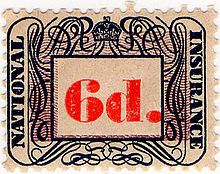National Insurance Act 1946: Difference between revisions
No edit summary |
No edit summary |
||
| Line 1: | Line 1: | ||
{{Infobox UK legislation|type=Act|year=1946|introduced_commons=[[Labour Party (UK)]]|royal_assent=1 August 1946|status=Repealed|millbankhansard=https://api.parliament.uk/historic-hansard/lords/1946/jun/25/national-insurance-bill}}[[File:1948 6d NI stamp.jpg|right|thumb|A British 1948 National Insurance stamp, once used to collect contributions to the scheme.]] |
{{Infobox UK legislation|type=Act|year=1946|introduced_commons=[[Labour Party (UK)]]|royal_assent=1 August 1946|status=Repealed|millbankhansard=https://api.parliament.uk/historic-hansard/lords/1946/jun/25/national-insurance-bill}}[[File:1948 6d NI stamp.jpg|right|thumb|A British 1948 National Insurance stamp, once used to collect contributions to the scheme.]] |
||
The '''National Insurance Act 1946''' (c 67) was a [[United Kingdom|British]] [[Act of Parliament]] which established a comprehensive system of social security throughout the United Kingdom. |
The '''National Insurance Act 1946''' (c 67) was a [[United Kingdom|British]] [[Act of Parliament]] passed during the [[Attlee ministry|Atlee ministry]] which established a comprehensive system of social security throughout the United Kingdom. |
||
| ⚫ | The act meant that all who were of working age were to pay a weekly contribution. If they had been paying National Insurance, mothers were to be entitled to an allowance (of 18 weeks)<ref>{{Cite web|last=Archives|first=The National|title=1940's Origins of the Welfare State|url=https://www.nationalarchives.gov.uk/cabinetpapers/alevelstudies/1940-origins-welfare-state.htm|access-date=2021-08-09|website=www.nationalarchives.gov.uk}}</ref> for each child as well as a lump sum when the child was born. The act however excluded married women. The weekly contributions meant that benefits including sickness benefit and unemployment benefits were able to be offered. Pensions were to offered to men and women at ages 60 and 65 respectively.<ref>{{Cite web|title=The National Insurance Act 1946|url=https://navigator.health.org.uk/theme/national-insurance-act-1946|access-date=2021-08-09|website=Policy Navigator|language=en}}</ref> |
||
== Background == |
|||
| ⚫ | The act meant that all who were of working age were to pay a weekly contribution. If they had been paying National Insurance, mothers were to be entitled to an allowance (of 18 weeks)<ref>{{Cite web|last=Archives|first=The National|title=1940's Origins of the Welfare State|url=https://www.nationalarchives.gov.uk/cabinetpapers/alevelstudies/1940-origins-welfare-state.htm|access-date=2021-08-09|website=www.nationalarchives.gov.uk}}</ref> for each child as well as a lump sum when the child was born. The act however excluded married women. The weekly contributions meant that benefits including sickness benefit and unemployment benefits were able to be offered. Pensions were to offered to men and women at ages 60 and 65 respectively.<ref>{{Cite web|title=The National Insurance Act 1946|url=https://navigator.health.org.uk/theme/national-insurance-act-1946|access-date=2021-08-09|website=Policy Navigator|language=en}}</ref> |
||
==Significance== |
==Significance== |
||
Revision as of 23:05, 9 August 2021
| Act of Parliament | |
 | |
| Introduced by | Labour Party (UK) (Commons) |
|---|---|
| Dates | |
| Royal assent | 1 August 1946 |
Status: Repealed | |
| Records of Parliamentary debate relating to the statute from Hansard | |

The National Insurance Act 1946 (c 67) was a British Act of Parliament passed during the Atlee ministry which established a comprehensive system of social security throughout the United Kingdom.
The act meant that all who were of working age were to pay a weekly contribution. If they had been paying National Insurance, mothers were to be entitled to an allowance (of 18 weeks)[1] for each child as well as a lump sum when the child was born. The act however excluded married women. The weekly contributions meant that benefits including sickness benefit and unemployment benefits were able to be offered. Pensions were to offered to men and women at ages 60 and 65 respectively.[2]
Significance
According to the historian Kenneth O. Morgan, the Act constituted "a measure which provided a comprehensive universal basis for insurance provision that had hitherto been unknown".[3]
This section needs expansion. You can help by adding to it. (June 2017) |
See also
- UK labour law
- Welfare state
- National Insurance Act 1911
- National Insurance Act 1965 (c 51)
- Social Security Contributions and Benefits Act 1992
- Timeline of pensions in the United Kingdom
References
- ^ Archives, The National. "1940's Origins of the Welfare State". www.nationalarchives.gov.uk. Retrieved 2021-08-09.
- ^ "The National Insurance Act 1946". Policy Navigator. Retrieved 2021-08-09.
- ^ Taylor, David, Mastering Economic and Social History
